Crack Propagation Behavior of a Ni-Based Single-Crystal Superalloy during In Situ SEM Tensile Test at 1000 °C
Abstract
1. Introduction
2. Experiment and Materials
2.1. Materials
2.2. Experimental Procedure
3. Results
3.1. Loading-Displacement Curve and Fracture Behavior
3.2. Effect of Eutectics on Crack Propagation Path
3.3. Effect of Eutectics on Crack Propagation Rate
3.4. Microstructure and Element Distribution around the Eutectic
4. Discussion
5. Conclusions
Supplementary Materials
Author Contributions
Funding
Conflicts of Interest
References
- Joyce, M.; Wu, X.; Reed, P. The effect of environment and orientation on fatigue crack growth behaviour of CMSX-4 nickel base single crystal at 650 °C. Mater. Lett. 2004, 58, 99–103. [Google Scholar] [CrossRef]
- Reed, R.C. Superalloys: Fundamentals and Applications; Cambridge University Press: Cambridge, UK, 2006; pp. 40–49. [Google Scholar]
- Wang, J.; Guo, W.-G.; Li, P.; Zhou, P.; Wang, Z. Dynamic tensile properties of a single crystal Nickel-base superalloy at high temperatures measured with an improved SHTB technique. Mater. Sci. Eng. A 2016, 670, 1–8. [Google Scholar] [CrossRef]
- Xiong, X.; Quan, D.; Dai, P.; Wang, Z.; Zhang, Q.; Yue, Z. Tensile behavior of nickel-base single-crystal superalloy DD6. Mater. Sci. Eng. A 2015, 636, 608–612. [Google Scholar] [CrossRef]
- Li, Z.; Wen, Z.; Gu, S.; Pei, H.; Gao, H.; Mao, Q. In-situ observation of crack initiation and propagation in Ni-based superalloy with film cooling holes during tensile test. J. Alloys Compd. 2019, 793, 65–76. [Google Scholar] [CrossRef]
- Ci, S.; Liang, J.; Li, J.; Zhou, Y.; Sun, X. Microstructure and tensile properties of DD32 single crystal ni-base superalloy repaired by laser metal forming. J. Mater. Sci. Technol. 2020, 45, 23–34. [Google Scholar] [CrossRef]
- Wang, X.; Liu, J.; Jin, T.; Sun, X. Tensile behaviors and deformation mechanisms of a nickel-base single crystal superalloy at different temperatures. Mater. Sci. Eng. A 2014, 598, 154–161. [Google Scholar] [CrossRef]
- Shang, Z.; Wei, X.; Song, D.; Zou, J.; Liang, S.; Liu, G.; Nie, L.; Gong, X. Microstructure and mechanical properties of a new nickel-based single crystal superalloy. J. Mater. Sci. Technol. 2020, 9, 11641–11649. [Google Scholar] [CrossRef]
- Thorton, P.; Davies, R.; Johnston, T. The temperature dependence of the flow stress of the γ′ phase based upon Ni3Al. Metall. Trans. 1970, 1, 207–218. [Google Scholar]
- Nembach, E.; Pesicka, J.; Langmaack, E. The high-temperature decrease of the yield strength of the γ′-strengthened superalloys NIMONIC PE16 and NIMONIC 105. Mater. Sci. Eng. A 2003, 362, 264–273. [Google Scholar] [CrossRef]
- Gasko, K.; Janowski, G.; Pletka, B. The influence of γ-γ′ eutectic on the mechanical properties of conventionally cast MAR-M247. Mater. Sci. Eng. A 1988, 104, 1–8. [Google Scholar] [CrossRef]
- Miao, J.; Pollock, T.M.; Jones, J.W. Crystallographic fatigue crack initiation in nickel-based superalloy René 88DT at elevated temperature. Acta Mater. 2009, 57, 5964–5974. [Google Scholar] [CrossRef]
- Steuer, S.; Villechaise, P.; Pollock, T.M.; Cormier, J. Benefits of high gradient solidification for creep and low cycle fatigue of AM1 single crystal superalloy. Mater. Sci. Eng. A 2015, 645, 109–115. [Google Scholar] [CrossRef]
- Walston, W.; Bernstein, I.; Thompson, A. The Role of the γ/γ′ eutectic and porosity on the tensile behavior of a single-crystal nickel-base superalloy. Metall. Trans. A 1991, 22, 1443–1451. [Google Scholar] [CrossRef]
- Zheng, L.; Zhang, G.; Lee, T.L.; Gorley, M.J.; Wang, Y.; Xiao, C.; Li, Z. The effects of Ta on the stress rupture properties and microstructural stability of a novel Ni-base superalloy for land-based high temperature applications. Mater. Des. 2014, 61, 61–69. [Google Scholar] [CrossRef]
- Rai, R.; Sahu, J.; Jena, P.; Das, S.K.; Paulose, N.; Fernando, C. High temperature tensile deformation of a directionally solidified nickel base superalloy: Role of micro constituents. Mater. Sci. Eng. A 2017, 705, 189–195. [Google Scholar] [CrossRef]
- Ponnusami, S.A.; Turteltaub, S.; van der Zwaag, S. Cohesive-zone modelling of crack nucleation and propagation in particulate composites. Eng. Fract. Mech. 2015, 149, 170–190. [Google Scholar] [CrossRef]
- Zhang, J.; Harada, H.; Ro, Y.; Koizumi, Y. Superior thermo-mechanical fatigue property of a superalloy due to its heterogeneous microstructure. Scr. Mater. 2006, 55, 731–734. [Google Scholar] [CrossRef]
- Ma, J.; Jiang, W.; Wang, J.; Zhang, Y.; Zhang, Z. Initial oxidation behavior of a single crystal superalloy during stress at 1150 °C. Sci. Rep. 2020, 10, 1–9. [Google Scholar] [CrossRef]
- Ma, J.; Lu, J.; Tang, L.; Wang, J.; Sang, L.; Zhang, Y.; Zhang, Z. A novel instrument for investigating the dynamic microstructure evolution of high temperature service materials up to 1150 °C in scanning electron microscope. Rev. Sci. Instrum. 2020, 91, 043704. [Google Scholar] [CrossRef]
- Chen, X.; Sakaguchi, M. Transition behavior from Mode I cracking to crystallographic cracking in a Ni-base single crystal superalloy. Int. J. Fatigue 2020, 132, 105400. [Google Scholar] [CrossRef]
- Paraschiv, A.; Matache, G.; Puscasu, C. The effect of heat treatment on the homogenization of CMSX-4 Single-Crystal Ni-Based Superalloy. Transp. Res. Procedia 2018, 29, 303–311. [Google Scholar] [CrossRef]
- Stoloff, N. Physical and mechanical metallurgy of Ni3Al and its alloys. Int. Mater. Rev. 1989, 34, 153–184. [Google Scholar] [CrossRef]
- Ding, Q.; Li, S.; Chen, L.-Q.; Han, X.; Zhang, Z.; Yu, Q.; Li, J. Re segregation at interfacial dislocation network in a nickel-based superalloy. Acta Mater. 2018, 154, 137–146. [Google Scholar] [CrossRef]
- Wang, G.; Liu, J.; Liu, J.; Wang, X.; Zhou, Y.; Sun, X.; Zhang, H.; Jin, T. Temperature dependence of tensile behavior and deformation microstructure of a Re-containing Ni-base single crystal superalloy. Mater. Des. 2017, 130, 131–139. [Google Scholar] [CrossRef]
- Barba, D.; Alabort, E.; Pedrazzini, S.; Collins, D.; Wilkinson, A.; Bagot, P.; Moody, M.; Atkinson, C.; Jérusalem, A.; Reed, R. On the microtwinning mechanism in a single crystal superalloy. Acta Mater. 2017, 135, 314–329. [Google Scholar] [CrossRef]
- Lang, Y.; Zhou, G.; Hou, L.; Zhang, J.; Zhuang, L. Significantly enhanced the ductility of the fine-grained Al–Zn–Mg–Cu alloy by strain-induced precipitation. Mater. Des. 2015, 88, 625–631. [Google Scholar] [CrossRef]

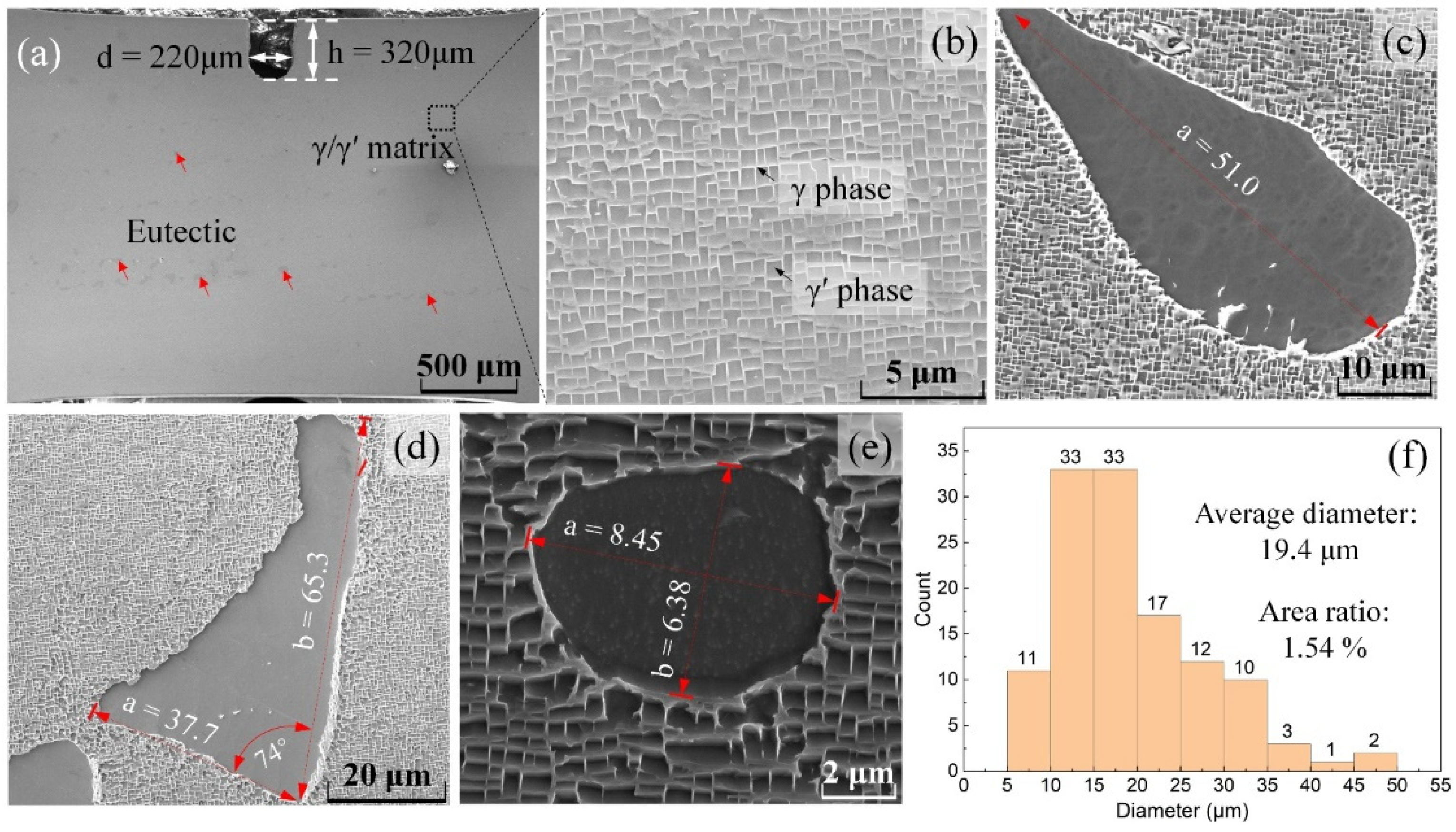
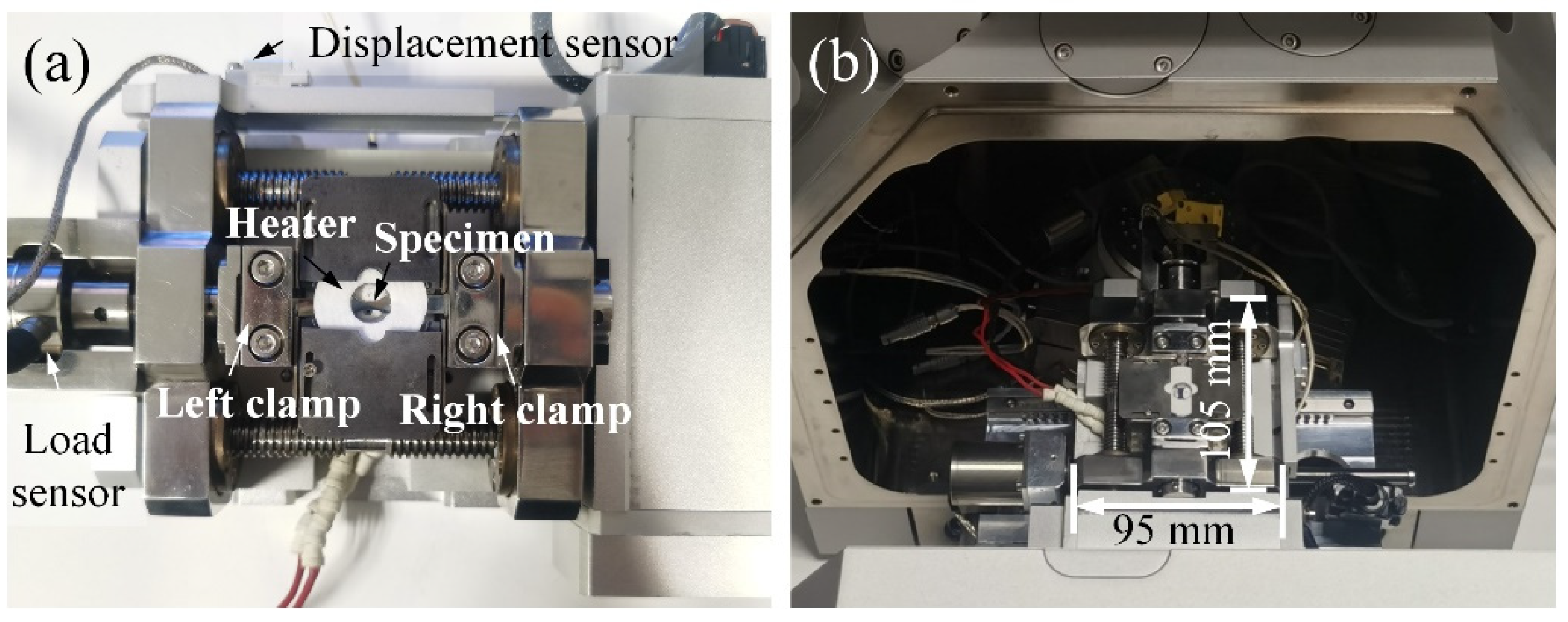



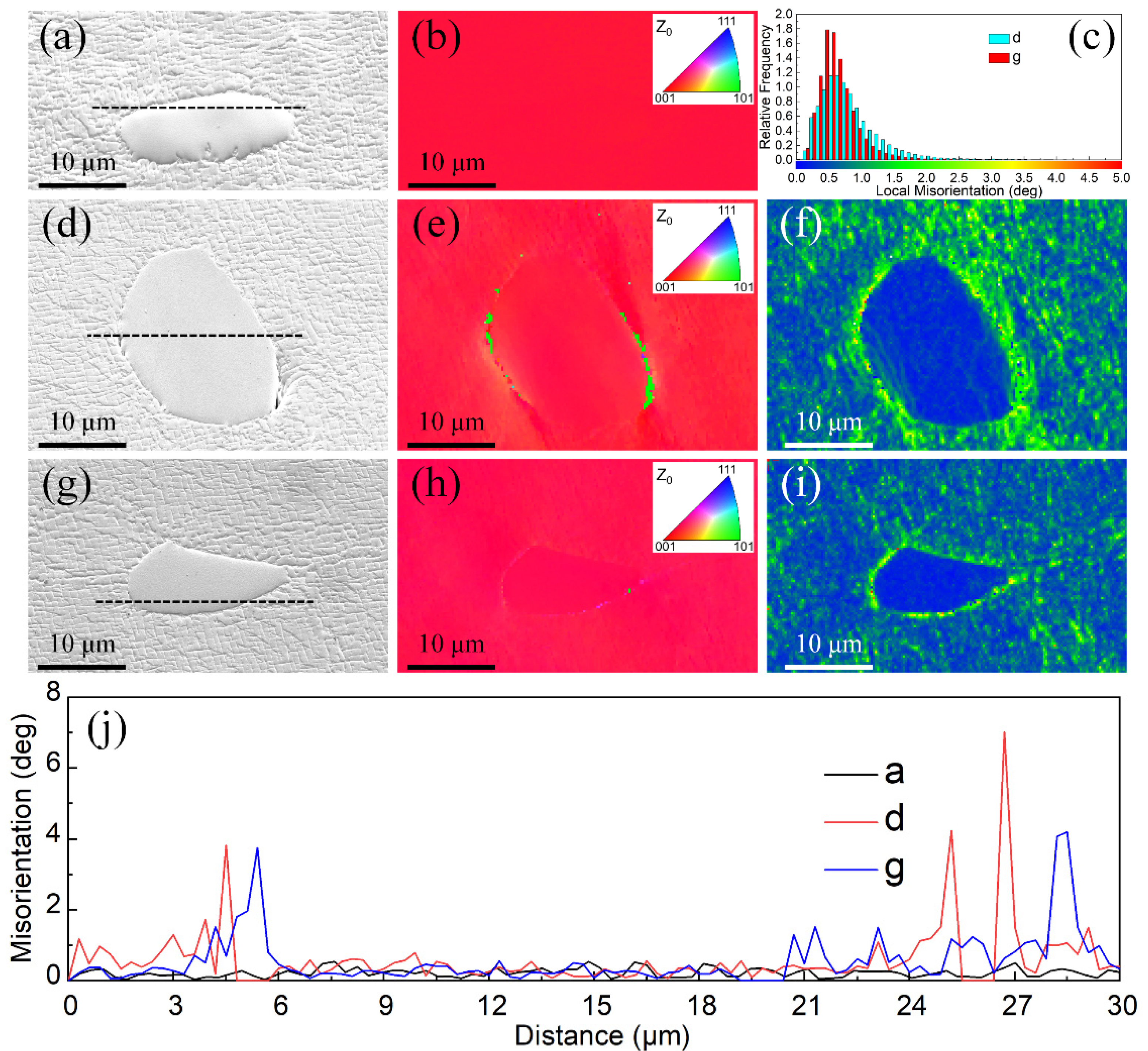
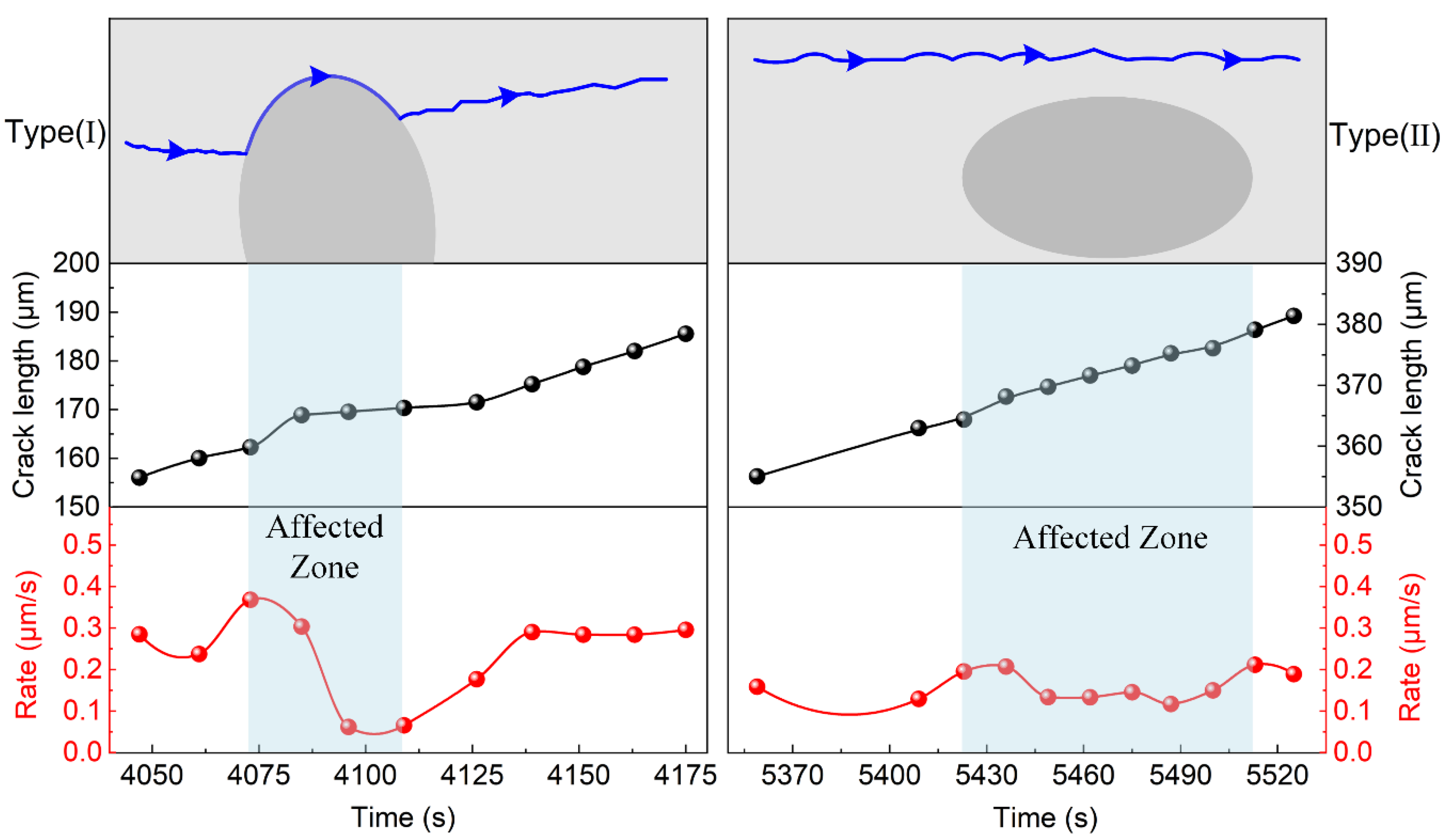
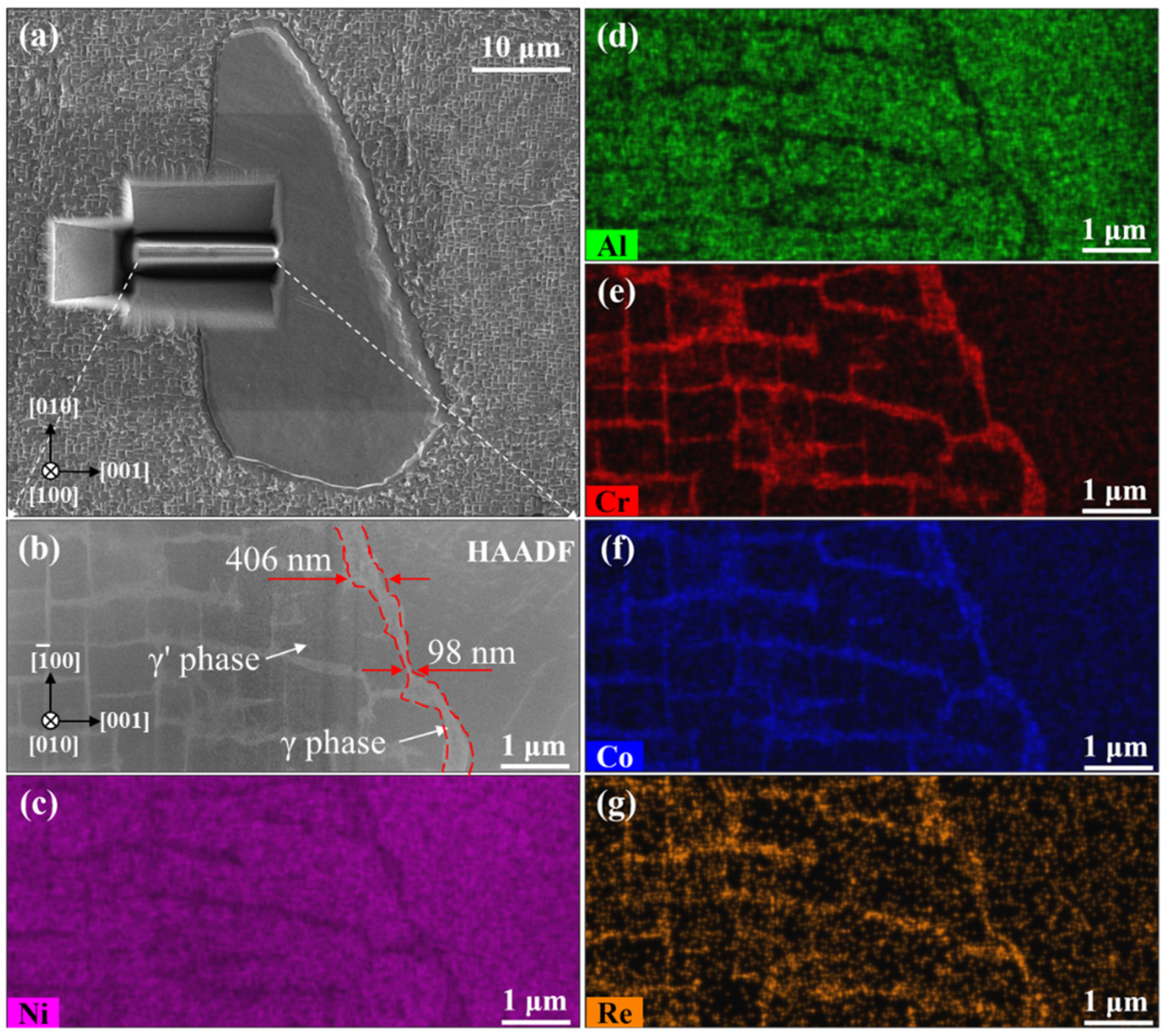

| Cr | Co | W | Al | Ta | Re | Mo | Hf | Nb | Ni |
|---|---|---|---|---|---|---|---|---|---|
| 4.3 | 9.1 | 8 | 5.2 | 6 | 2.5 | 1.5 | 0.1 | 0.5 | REST |
Publisher’s Note: MDPI stays neutral with regard to jurisdictional claims in published maps and institutional affiliations. |
© 2020 by the authors. Licensee MDPI, Basel, Switzerland. This article is an open access article distributed under the terms and conditions of the Creative Commons Attribution (CC BY) license (http://creativecommons.org/licenses/by/4.0/).
Share and Cite
Jiang, W.; Ren, X.; Zhao, J.; Zhou, J.; Ma, J.; Zhang, W.; Zhang, Y.; Zhang, Z. Crack Propagation Behavior of a Ni-Based Single-Crystal Superalloy during In Situ SEM Tensile Test at 1000 °C. Crystals 2020, 10, 1047. https://doi.org/10.3390/cryst10111047
Jiang W, Ren X, Zhao J, Zhou J, Ma J, Zhang W, Zhang Y, Zhang Z. Crack Propagation Behavior of a Ni-Based Single-Crystal Superalloy during In Situ SEM Tensile Test at 1000 °C. Crystals. 2020; 10(11):1047. https://doi.org/10.3390/cryst10111047
Chicago/Turabian StyleJiang, Wenxiang, Xiaoyi Ren, Jinghao Zhao, Jianli Zhou, Jinyao Ma, Wenjing Zhang, Yuefei Zhang, and Ze Zhang. 2020. "Crack Propagation Behavior of a Ni-Based Single-Crystal Superalloy during In Situ SEM Tensile Test at 1000 °C" Crystals 10, no. 11: 1047. https://doi.org/10.3390/cryst10111047
APA StyleJiang, W., Ren, X., Zhao, J., Zhou, J., Ma, J., Zhang, W., Zhang, Y., & Zhang, Z. (2020). Crack Propagation Behavior of a Ni-Based Single-Crystal Superalloy during In Situ SEM Tensile Test at 1000 °C. Crystals, 10(11), 1047. https://doi.org/10.3390/cryst10111047






